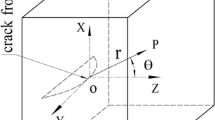Abstract
We propose to combine the crack tip stress field with acoustic cavitation to generate compressive residual stress at the crack tip in the bulk metal which is challenging to access. The sharply increasing stress profile (stress singularity) at the crack tip offers to amplify plastic deformation induced by the local impacts (shockwave/microjet) from the acoustic cavitation introduced to the crack tip, which then enhances the compressive residual stress generation at the crack tip. The effect of the crack tip stress field on compressive residual stress generation was experimentally investigated for crack depths of 10 and 20 mm. The experiments prove that the crack tip stress field increases the acoustic cavitation-based compressive residual stress by up to three times. Also, the stress intensity factor of the crack tip stress field was found suitable to represent the engagement of the crack tip stress field with the cavitation-based compressive residual generation.
Similar content being viewed by others
References
P. Murugesan, Y. Lim, S. Jung and H. Lee, Compressive residual stress generation at crack tip in bulk metal using acoustic cavitation, International Journal of Fatigue, 153 (2021) 106477.
M. Mathias, A. Göcke and M. Pohl, The residual stress, texture and surface changes in steel induced by cavitation, Wear, 150 (1991) 11–20.
M. R. Sriraman and R. Vasudevan, Influence of ultrasonic cavitation on surface residual stresses in AISI 304 stainless steel, Journal of Material Science, 33 (1998) 2899–2904.
S. Jung, M. Prabhu and H. Lee, Peening narrow nozzles of reactor pressure vessels using ultrasonic cavitation, Journal of Mechanical Science and Technology, 31(11) (2017) 5279–5283.
S. Jung, M. Prabhu and H. Lee, Peening the tip of notch using ultrasonic cavitation, Ultrasonics, 82 (2018) 322–326.
F. Bai, K. A. Saalbach, Y. Long, J. Twiefel and J. Wallaschek, Capability evaluation of ultrasonic cavitation peening at different standoff distances, Ultrasonics, 84 (2018) 34–44.
Y. Lim, P. Murugesan, S. Jung and H. Lee, Evaluation of residual stress from ultrasonic cavitation peening using cavitation pit analysis and FEA, International Journal of Mechanical Sciences, 198 (2021) 106352.
J. C. Xu, D. Q. Zhang and B. J. Shen, The fatigue strength and fracture morphology of leaf spring streel after prestressed shot peening, Proceedings of the 1st International Conference on Shot Peening, Paris, France (1981) 367–371.
C. F. Barret and R. Todd, Investigation of the effects of elastic pre-stressing technique on magnitude of compressive residual stress induced by shot peening of thick Aluminum plates, Proceedings of the 2nd International Conference on Shot Peening, Chicago, IL, USA (1984) 15–21.
B. Sadasivam, A. Hizal and D. Arola, Abrasive waterjet peening with elastic prestress: A parametric evaluation, International Journal of Machine Tools and Manufacture, 49 (2009) 134–141.
H. Y. Miao, D. Demers, S. Larose, C. Perron and M. Lévesque, Experimental study of shot peening and stress peen forming, Journal of Materials Processing Technology, 210 (2010) 2089–2102.
K. Zhan, C. H. Jiang and V. Ji, Effect of prestress state on surface layer characteristic of S30432 austenitic stainless steel in shot peening process, Materials and Design, 42 (2012) 89–93.
Y. Hu, Z. Li, X. Yu and Z. Yao, Effect of elastic prestress on the laser peen forming of aluminum alloy 2024-T351: experiments and eigenstrain-based modelling, Journal of Material Processing Technology, 221 (2015) 214–224.
H. Tada, P. C. Paris and G. R. Irwin, The Stress Analysis of Cracks Handbooks, 3rd Ed., ASME Press, New York, USA (2000).
Acknowledgments
This research was funded by the National Research Foundation of Korea (NRF) funded by the Ministry of Education (NRF-2020R1F1A1056924) and the Ministry of Science, ICT & Future Planning (NRF-2016 M2B2A9A 02945208).
Author information
Authors and Affiliations
Corresponding author
Additional information
Sunghwan Jung received his B.S. degree in mechanical engineering from the University of Iowa, Iowa City, IA, in 1993. He received his M.S. and Ph.D. degrees in mechanical engineering from the Massachusetts Institute of Technology, Cambridge, MA, in 1995 and 2007, respectively. He is currently a Professor in Dankook University, Korea. His research interests include ultrasonic cavitation peening/cleaning, fracture mechanics, wafer spalling, and microfluidics.
Rights and permissions
About this article
Cite this article
Murugesan, P., Jung, S. & Lee, H. Pre-loading enhancement of compressive residual stress at crack-tip in acoustic cavitation. J Mech Sci Technol 37, 1255–1261 (2023). https://doi.org/10.1007/s12206-023-0213-3
Received:
Revised:
Accepted:
Published:
Issue Date:
DOI: https://doi.org/10.1007/s12206-023-0213-3




